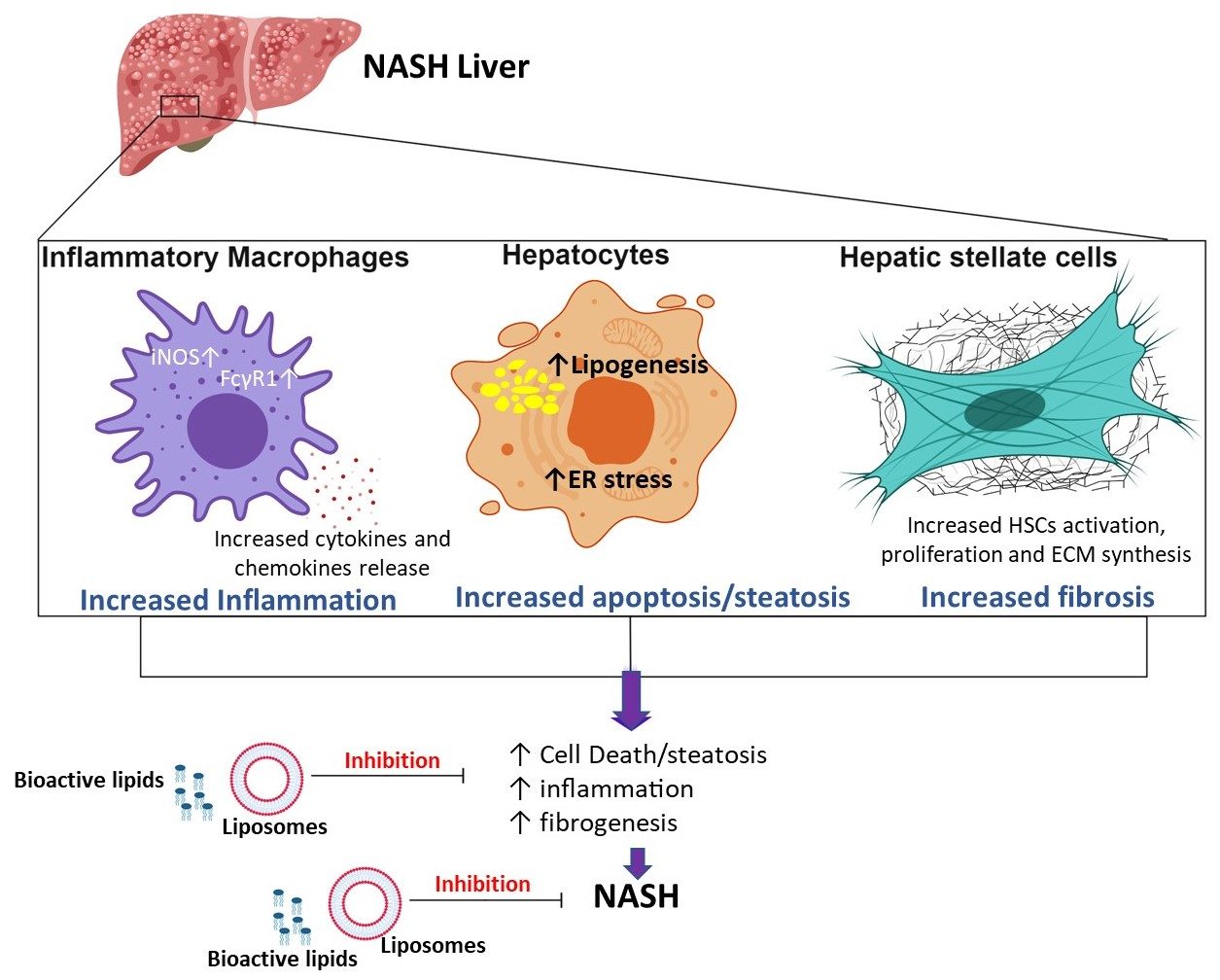Bioactive liposomes for the treatment of Non-Alcoholic SteatoHepatitis (NASH)
Assist.Prof. Dr. R. Bansal1), University Twente/The Netherlands
People involved
Tarun Ojha, PhD (Postdoc fellow sponsored by the PRC) – University of Twente/The Netherlands (t.a.ojha@utwente.nl)
Abstract
Non-alcoholic fatty liver disease (NAFLD), closely associated with obesity and metabolic syndrome affecting 20–35% population worldwide, is the leading cause of liver transplantation. Non-alcoholic steatohepatitis (NASH) is the most aggressive form of NAFLD that progresses to end-stage liver failure and liver cancer, and there is no curative therapy available.1) Therefore, efforts are urgently required to develop therapies for the treatment of NASH.
Lipid-associated hepatocellular damage, chronic inflammation, and fibrosis are the hallmarks of NASH. Lipidomic analyses in NASH patients have revealed the accumulation of ‘toxic’ lipids such as saturated fatty acids, free cholesterol, and complex lipids (glycerophospholipids and sphingolipids), and deficiency of ‘healthy’ lipids that are ω-3 polyunsaturated fatty acids (PUFA) and PUFA-derived specialized pro-resolving mediators (SPMs). Furthermore, high-fat diet induced a disproportional increase in full-length (inflammatory) over truncated (pro-resolving) oxidized phospholipids (OxPLs).2)3)4)
Since pro-resolving bioactive lipids (SPMs and truncated OxPLs) are decreased during NASH, it is hypothesized that replenishment of these bioactive lipids would be a highly promising approach for the treatment of NASH. However, these lipids are poorly water-soluble and usually administered in ethanol in preclinical studies. The aim is to incorporate these pro-resolving lipids in liposomes (bioactive liposomes) to improve their solubility and bioavailability. Overall, this project will address the pro-resolving activity of bioactive liposomes, containing SPMs and truncated OxPLs, in NASH. The proposed research may open new therapeutic opportunities for the treatment of other chronic diseases as well.

Bioactive liposomes to treat NASH. During non-alcoholic steatohepatitis (NASH), parenchymal cells e.g. hepatocytes, and non-parenchymal cells e.g. macrophages and hepatic stellate cells are severely affected. Hepatocytes, due to accumulation of ‘toxic’ lipids, undergo apoptosis and exhibit increased lipogenesis and organelle dysfunction e.g. ER stress resulting in cell death/steatosis. In response, macrophages (resident macrophages and infiltrating monocytes) display a proinflammatory phenotype (increased iNOS and FcγR1) by releasing pro-inflammatory cytokines and chemokines leading to chronic liver inflammation and activated hepatic stellate cells (HSCs). HSCs undergo phenotypic transformation into activated, proliferative, extracellular matrix (ECM) producing and highly proliferative myofibroblasts resulting in fibrosis development. These multicellular processes result in NASH with accelerated cell death, steatosis, chronic inflammation and fibrosis. We propose that these processes can be attenuated by bioactive liposomes incorporating the pro-resolving ‘healthy’ lipids with inhibition of the disease progression as an outcome. This project therefore will advance our knowledge about the utility of pro-resolving bioactive lipids for halting NASH. If successful, effective treatment of other chronic pathologies can be envisioned.
Benefit for the community
The aim of this project is to develop bioactive liposomes as a prospective treatment for non-alcoholic fatty liver disease, that progresses to end-stage liver failure and liver cancer, affecting millions of people worldwide. This project will benefit the scientific, societal (patients) and healthcare communities.
Visit the supervisors lab
Global burden of NAFLD and NASH: trends, predictions, risk factors and prevention
Nat. Rev. Gastroenterol. Hepatol. 15, 11
| PubMed |
Non-alcoholic steatohepatitis: emerging molecular targets and therapeutic strategies
Nat. Rev. Drug Discovery 15, 249
| PubMed |
Bioactive Lipid Species and Metabolic Pathways in Progression and Resolution of Nonalcoholic Steatohepatitis
Gastroenterology 155, 282
| PubMed |
Macrophage phenotype and bioenergetics are controlled by oxidized phospholipids identified in lean and obese adipose tissue
Proc. Natl. Acad. Sci. USA 115, E6254
| PNAS |
Hepatic lipidome: from basic science to clinical translation
Adv. Drug Delivery Rev. 159, 180-197
| PubMed |


